Wasted Mobile Data: The $1bn problem
Despite the huge and never-ending investment in newer and faster wireless technologies, it’s generally assumed that the mobile network operators are primarily responsible when their apparently clogged pipes fail to meet subscribers’ performance expectations for delivering content from over-the-top (OTT) providers, or when the latest and greatest smartphone fails to repeatedly deliver the user experience that their owners expect. But as often happens, this conventional wisdom is wrong.
October 10, 2012

By micke111
Despite the huge and never-ending investment in newer and faster wireless technologies, it’s generally assumed that the mobile network operators are primarily responsible when their apparently clogged pipes fail to meet subscribers’ performance expectations for delivering content from over-the-top (OTT) providers, or when the latest and greatest smartphone fails to repeatedly deliver the user experience that their owners expect. But as often happens, this conventional wisdom is wrong. The reality is that between them, OTTs and OEMs are unwittingly creating a problem which is costing US operators over $1bn per year, and which is impacting the user experience of their own services and every other service on the mobile networks.
The $1bn problem — “Wasted Data”: If two different devices with comparable specifications are used to download and display the same content while everything else is held constant (mobile data network, time of day, username), then most of us would expect the amount of downloaded data to be about the same. It isn’t. Nowhere near in some cases. What we see in practice is that when tests are performed that measure what an actual end user sees (i.e. in a live environment with live data), wide variations exist between devices in terms of the amount of data downloaded, and the excess data is effectively unused — it’s wasted. This is not “signaling traffic.” It’s actual “user” data passing across the network which is unnecessary for the action that the user has requested. The differences in the amount of data can be quite startling and completely unexpected. For instance, take a look at charts 1 and 2.
Chart 1 shows that a signature Motorola device running Android “Gingerbread” consumes 70KB (140 per cent) more data than the iPhone 4S to perform exactly the same operation (viewing a friend’s wall on Facebook).
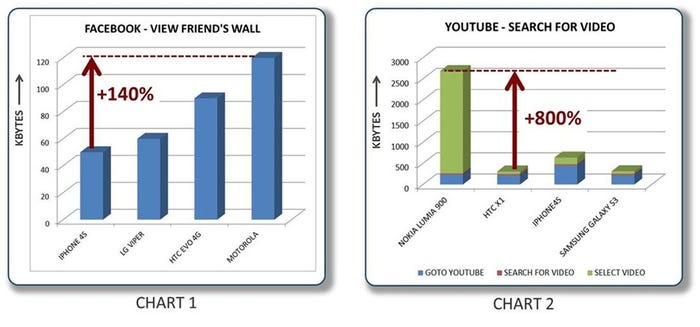
Chart 2 shows that the Nokia Lumia 900 consumes a staggering 2.4MB (800 per cent) more data than three other equivalent devices when searching for the same YouTube video.
These are not isolated examples. Everywhere we look, we find the same propensity for different devices to download different amounts of OTT data for the same output. And it’s not always the same devices that appear to waste data. While the Lumia performed badly on a YouTube search, it performed significantly better than the three other devices on a Google search, each of which consumed (i.e., wasted) about 200KB more data than the Lumia.
Most surprising of all, we see the same “wasted data” effect between different versions of the same base operating system. For instance, one particular device running Android version 2.3.x displays the same behavior as the Lumia on a YouTube search (downloading the entire video before the user has decided whether to play it or not), while the same device running Android 4.0.x has one of the smallest data footprints on exactly the same test.
Now, 70KB here and 200KB there might not seem like much on wireless networks which are now delivering multi-megabit data rates. But remember, this isn’t just happening now and again. OTT apps such as Facebook, YouTube and Google are used countless times per day on tens of millions of mobile devices. They represent a very significant percentage of the total data network footprint, so having even small amounts of waste on almost every page adds up very quickly.
Wasted data impacts everyone: Wasted data exists and it seems to be endemic on every device on every application on every network. As a result, it’s having a major impact on operators, OTTs and the whole mobile data ecosystem.
1) The impact on operators: Wasted data, just like usable data, has a cost because it consumes network bandwidth. Based on figures taken from Chetan Sharma’s “US Wireless Market Update, Q1 2012” (specifically, how much data flows across the US wireless networks per month, and the market share of US operators), we calculated a low-end and high-end cost of wasted data to the US operators. The results are shown in chart 3.
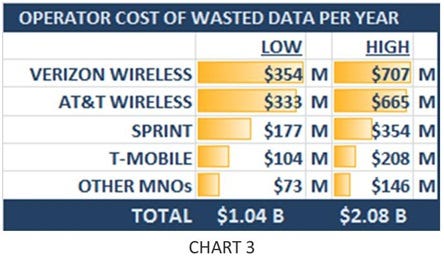
Why does this cost matter to operators who charge subscribers according to the overall amount of data they use? Isn’t wasted data actually contributing to their revenue? No, it’s not. In the overwhelming number of cases, operators are not recovering the cost of wasted data for one simple reason: It’s not pushing subscribers into another pricing band. According to recent statement from AT&T, the company estimates that “… its top 5 percent of smartphone data users are consuming 2GB to 3GB, so for most, a 4GB bucket is as good as unlimited.” Looked at another way, reducing wasted data on AT&T’s network would actually result in the same revenue but at a lower cost.
Wasted data also saps the operators’ capital investments in networks, forcing them into earlier-than-forecast capital expenditures on upgrades which could be delayed or even cancelled without the additional wasted data traffic.
A second major impact area for operators is “no fault found” device returns. When customers buy a smartphone, it’s increasingly likely that it is a replacement for an existing device. Their expectation is that the new device will perform at least as fast as their old device and also other devices owned by friends and family. If those expectations aren’t met because that particular combination of device, application and OTT suffers from wasted data, the customer will return the device as “faulty”. The operator then spends time and money testing the device without discovering any faults, and has to resell the device as “refurbished” at a lower margin. This increases their support costs and makes the device less profitable for them. It also impacts the device OEM who suffers lower sales and also brand damage because of the increasing market perception that the device seems to be slow on Facebook or YouTube or Google.
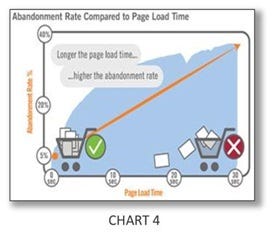 2) The impact on OTTs: As shown in chart 4, there is a clear link between the performance of mobile applications and users’ adoption of those applications. Compuware and many other companies have done extensive research on this subject, and found that even a one second slowdown can cause page abandonment (the typical measure of users’ impatience) to increase by 20 per cent. For many OTTs, this is a disaster: Their business model is predicated on a growing user base which in turn attracts more advertising revenue.
2) The impact on OTTs: As shown in chart 4, there is a clear link between the performance of mobile applications and users’ adoption of those applications. Compuware and many other companies have done extensive research on this subject, and found that even a one second slowdown can cause page abandonment (the typical measure of users’ impatience) to increase by 20 per cent. For many OTTs, this is a disaster: Their business model is predicated on a growing user base which in turn attracts more advertising revenue.
Applications that consume more bytes than necessary to provide the content requested will run slower than the same application without the wasted bytes. Wasted data means lower performance and it will significantly increase the likelihood of the user abandoning the page.
3) The impact on everyone else: So far, we’ve only discussed the direct impact of wasted data on operators, OTTs and device OEMs themselves, but the reality is that it affects everyone on the network, too. Wasted data occupies bandwidth, and as this disruption increases, it will indiscriminately reduce the bandwidth available to any application which is sharing the same network. Without getting into the technicalities of queuing theory, when busy networks which are close to their capacity get busier, the slowdown effect becomes even more pronounced — a small increase in data traffic can result in a significant slowdown for everyone.
Why haven’t we heard about this problem before? Wasted data is not just a simple device or application effect; if it was, then OTTs, device OEMs and operators would almost certainly see it and fix it during the development and test phases. The only way to detect it is with modern tools that can look at the entire service delivery chain (the device, the application, the mobile data network and the OTT content) from the only point-of-view that really matters — the end user —and not just at the discrete parts.
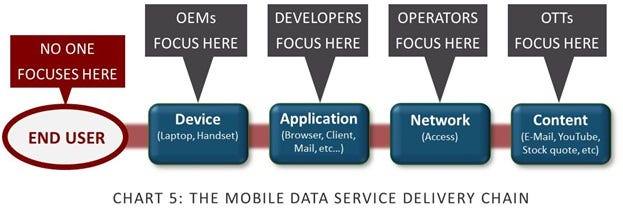
The data management tools in use today tend to be focused on the part of the delivery chain that each constituent owns (chart 5). OEMs focus on the device, developers focus on the application, operators focus on the network, and OTTs focus on content. Each on their own is blind to wasted data. They simply see how well their part of the chain is working and how well the bytes are moving, not whether those bytes are useful or not. It’s not until all the pieces are put together on an actual data network and measurements are done from an end-user perspective that the “wasted data” effect can be observed and measured. This is not the way that things are done today, and as a result, without the relevant end-user view, wasted data goes completely unnoticed by OTTs, OEMs and operators.
What can be done to fix the problem? First, this is an industry-wide problem that needs an industry-wide solution. Since the operators are the only common factor – and the ones having to bear the biggest financial burden — they have to lead an industry-wide initiative to raise the awareness of the issue with the OTTs and their own device OEMs.
Second, they have to coordinate the testing of devices and applications by setting out a series of end-user experience tests which the OEMs and OTTs must run. Since it’s in everyone’s interest to reduce or eliminate wasted data, most OEMs and OTTs should embrace such an initiative, rather than seeing it as a return to the old days of protecting access to a walled garden.
Fortunately, with the right tools, there is a pragmatic approach that can give actionable and significant results in days. The key to the problem is picking the right combination of use cases which gives the best return for the smallest amount of test effort. In other words:
– What are the top three or four most used devices on a particular network?
– What are the top three applications which generate the most network data? (Almost without exception, the answer is already there: Facebook, YouTube and Google).
– Finally, what is the most common use case with each of those applications? On Facebook for instance, one of the most common use cases is logging in and viewing a newsfeed, looking at a friend’s wall and a picture.
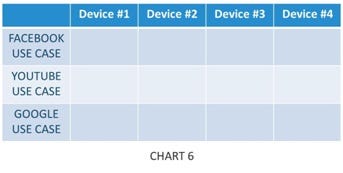
The resulting matrix (chart 6) consists of the 12 tests which need to be performed. These will measure the actual user experience (response time) and number of bytes downloaded to provide a simple way to check for wasted data.
There are SaaS-based tools available which can automate these tests and run them repeatedly across the live data network, including sophisticated reporting capabilities. In fact, these are exactly the same tools as we used to discover and quantify wasted data in the first place.
Conclusion: Wasted data is a billion dollar problem which very few operators, OTTs and OEMs are aware of. It impacts everyone in the service delivery chain, and eliminating it can provide more profits for operators, a better user experience for OTTs and improve overall data network performance for everyone. And it can be fixed simply and easily with the right approach and the right tools.
So now that you know about it, what are you going to do about it?
Mark Hillman, SVP Strategy and Business Development for Compuware
Mark Hillman, SVP Strategy and Business Development for Compuware
You May Also Like
.png?width=300&auto=webp&quality=80&disable=upscale)







.png?width=300&auto=webp&quality=80&disable=upscale)


_1.jpg?width=300&auto=webp&quality=80&disable=upscale)